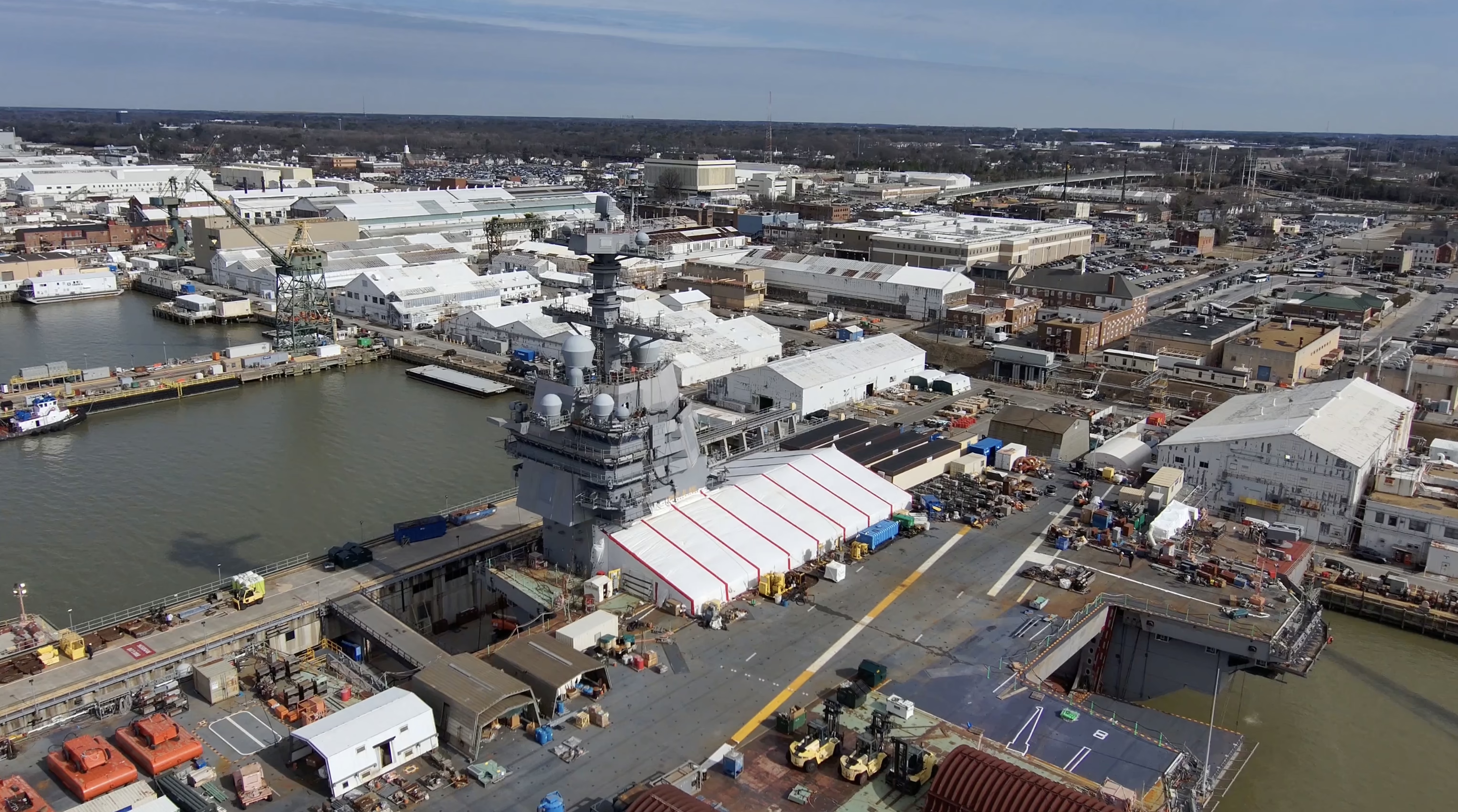Photo caption: PHILIPPINE SEA (JUNE 13, 2024) Sailors assigned to Explosive Ordnance Disposal Mobile Unit (EODMU) 5 conduct fast-rope and rappel training from an MH-60S Seahawk Helicopter from the “Golden Falcons” of Helicopter Sea Combat Squadron (HSC) 12 onto the flight deck of the Ticonderoga-class guided-missile cruiser USS Robert Smalls (CG 62) during Valiant Shield 2024. USS Robert Smalls was built at Ingalls Shipbuilding and commissioned into service in 1989.
June 14, 2024
HII’s Weekly News Digest is compiled every Friday by the Corporate Communications team to summarize and highlight news stories of significance to the company.
House’s $833 Billion Defense Bill Funds Just One SSN: Breaking Defense reported on Thursday that the House Appropriations Committee has approved its $833 billion defense budget bill for fiscal year 2025. Politico reported on Thursday that the bill increases funding for the F-35 fighter but buys only one Virginia-class attack submarine. Defense Appropriations Chair Ken Calvert, R-Calif., fired back at criticism from submarine advocates over his choice to fund the procurement of only one attack boat, rather than adding a second as supporters in both parties wanted. The subcommittee chair said funding a second sub can’t be executed given the backlog at shipyards, and federal dollars are better spent on boosting the industrial base to more quickly produce boats. Defense News reported on Tuesday that the White House has also raised objections to some of the House Armed Service Committee’s provisions on shipbuilding, including the inclusion of funds for a second Virginia-class sub. Instead, the Biden administration “encourages Congress to fully support the near-term submarine industrial base investments proposed in the president’s FY25 budget request.” Meanwhile, Inside Defense reported on Tuesday that the International Association of Machinists and Aerospace Workers (IAMAW) submitted a letter to House appropriators calling for them to fund two Virginia-class boats. Many lawmakers and industry experts believe a consistent two-per-year funding cadence is needed to support the totality of the submarine supply chain.
Experts Question 100% Ship Design Provision: Breaking Defense reported on Wednesday that Marine Corps engineers, former Navy officials and defense analysts are skeptical of a provision in the House version of the annual defense policy bill that would dictate the Navy should complete a ship’s design “100 percent” before starting lead ship construction. Experts identified in the article questioned whether the mandate would block the service from ensuring that new warships incorporate state-of-the-art technologies. “If you’re building something technologically complex, and you expect it to last in some form for 30, 40, 50 years, it’s not necessarily realistic to think that … you won’t make changes in design as the ship is built,” said Bradley Martin, a senior policy researcher at RAND. Rep. Joe Courtney, D-Conn., who is spearheading the provision, has said the requirement is not meant to ensure every “nut and screw” is locked down and instead tries to better align the Navy with a law passed in 2020 which mandates the service have a “complete” design prior to lead ship construction.
Japan Reverses Defense Industry Downsizing While Aiding US: Breaking Defense reported on Wednesday that Japan is taking steps to revitalize its defense industry and entice new entrants into the sector, despite being faced with an aging workforce, an ailing supply chain and a shrinking defense industrial base. Over the past 20 years, more than 100 major Japanese companies have downsized or withdrawn from the defense industry due to weak profit margins, wrote Miki Matsuo, a former visiting fellow with the Center for Strategic and International Studies in a paper published in May. Over the past decade, the Japanese government also increased acquisition spending on foreign technologies, constricting its indigenous industry. Those factors have hollowed out second- and third-tier suppliers, said Yuki Tatsumi, director of the Japan program at the Stimson Center. Only last year, the Japanese government passed legislation to reinvigorate the defense industrial base by creating new mechanisms to inject cash into the country’s arms manufacturers and their supply chain. The efforts come as U.S. officials increasingly call on Japan for its help to replenish missile inventories and repair warships, the Associated Press reported on Tuesday. Talks this week between Japanese and U.S. officials aimed to accelerate military industry cooperation. On Tuesday, the two countries held the first meeting of a Japanese shipyard repair working group, which would help U.S. shipbuilders focus on building new ships while allowing ships to be repaired in Japan for greater efficiency and deterrence.
Social Media Highlight Of The Week 
Posted Thursday to Mission Technologies’ LinkedIn page: “Andy Green, executive vice president of HII and president of HII Mission Technologies, spoke on the Hudson Institutes panel, “The New Iron Triangle: Achieving Adaptability and Scale in Defense Acquisition” on June 12. Green was joined by leaders in the DoD space including U.S. Rep, First District of Virginia, Rob Wittman. ” |
Marines Plan Training Overhaul: USNI News reported on Wednesday that the Marine Corps has published plans to modernize how it trains and educates warfighters so they are equipped for multi-domain fights against peer adversaries. The Training and Education Annual Report directs 37 separate force design-related actions from new policies, goals and standards to reshape Marines’ individual training and education and revamp units’ collective training. The efforts are codified under the Marine Corps Training and Education Command’s Project Triumph, Project Trident or Project Tripoli. Project Triumph is shifting Marines’ training and education away from lectures and into a digital learning model that fosters more critical thinking and cognitively agile warfighters. Project Trident is equipping Marines with more lethality and Project Tripoli is standardizing and revamping units’ through expanded live, virtual and constructive training environments, and digital battle spaces that combine real, virtual and computer-generated forces. While a portion of the report recognizes the need to better coordinate maritime integration with the Navy, a sore spot remains in amphibious shipping and underfunded ship sustainment. “We need the Navy and the Marine Corps to remain focused and keep pushing with Congress for all of the funds that are necessary to sustain that 31-ship amphib fleet,” Training and Education Command commander Lt. Gen. Kevin Iiams said.
Wittman: Narrow CJADC2 Efforts For Better Results: Defense Daily reported on Wednesday that House Armed Services Committee Vice Chairman Rep. Rob Wittman, R-Va., wants the Defense Department to narrow its initial efforts to develop capabilities for a more interconnected battlespace and focus on the key ingredient to make Combined Joint All Domain Command and Control (CJADC2) a reality. The existing data link network is too narrow and the data pipeline must be widened to accommodate the intelligence, surveillance, reconnaissance, and targeting data that will enable CJADC2, Wittman told participants during a fireside chat hosted by the Hudson Institute. Wittman said the U.S. Space Force’s Commercial Augmentation Space Reserve (CASR) needs to be put on “steroids.” CASR is a framework to leverage commercial capabilities through pre-negotiated contracts that would be used during crisis or conflict, complementing government-owned systems, and enhancing the capacity and resilience of the national security space architecture. Meanwhile, DefenseScoop reported on Wednesday that the Army’s piece of CJADC2, known as Project Convergence, was examined earlier this year. The exercise, known as PCC4, achieved a higher level of integration between mission partners than had been previously achieved.
HII’s Weekly News Digest is produced by HII’s Corporate Communications team and posted to Homeport every Friday.
Please note: Social media is blocked on HII computers for most employees. Employees are encouraged to visit HII’s Facebook page and other social media sites on personal time and from non-work devices.
Send feedback to: HII_Communications@hii-co.com.












